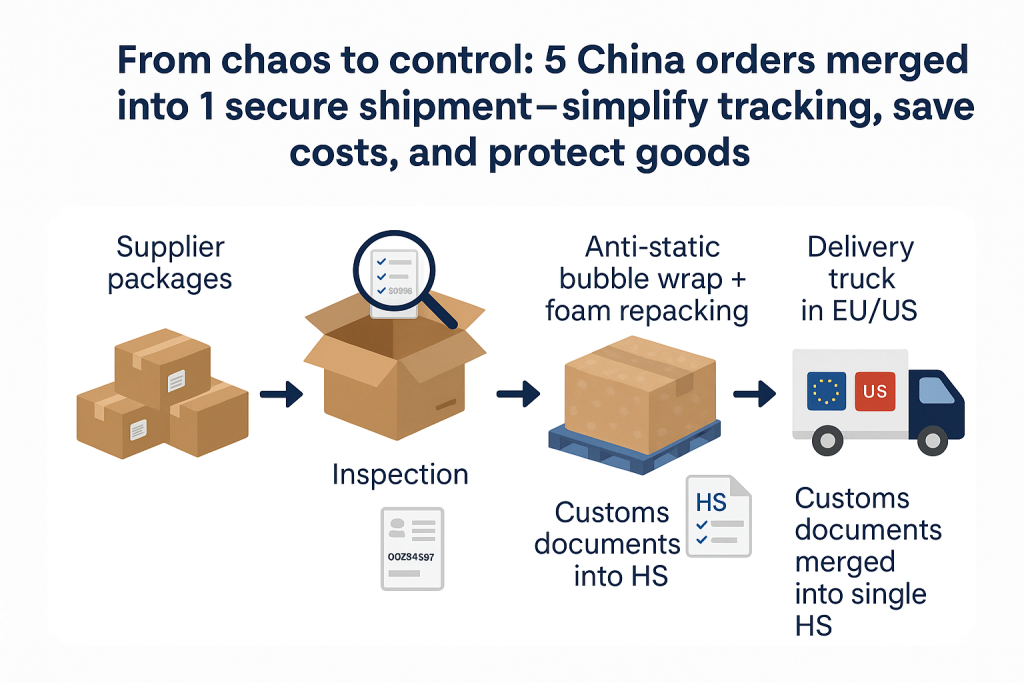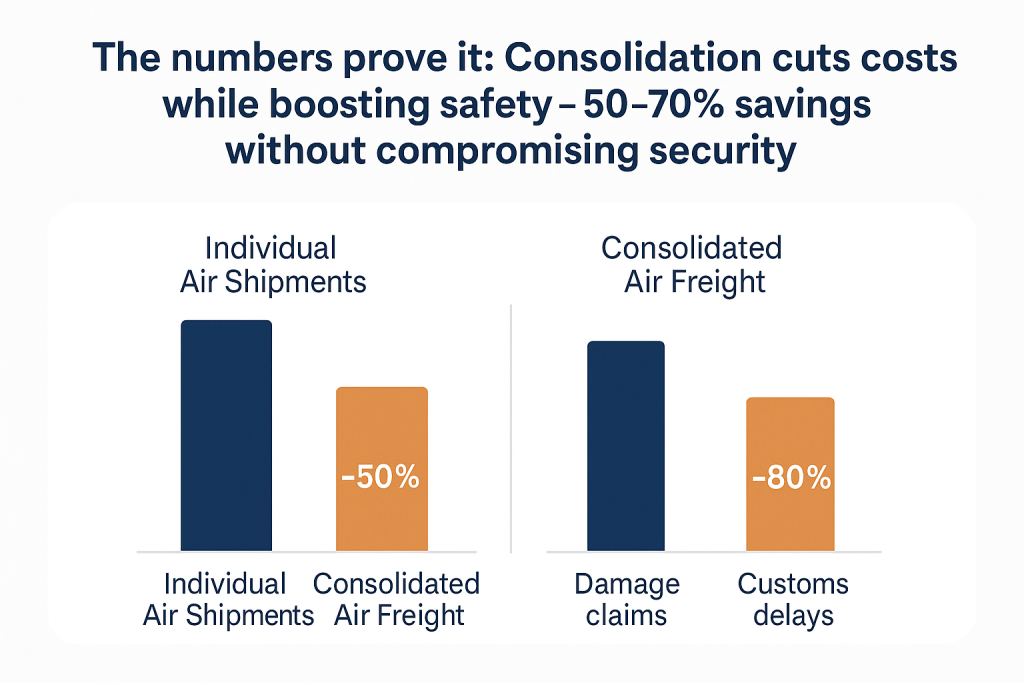Simplify Your Imports: The Ultimate Guide to Consolidating Multiple Orders from China Safely & Cost-Effectively for European & North American Buyers
Are you overwhelmed by the chaos of managing multiple shipments from China to Europe or North America? Whether you’re a business sourcing electronics, furniture, or clothing from Alibaba, Taobao, or JD.com—or an individual shopper bringing home decor, tech gadgets, or personal items—consolidating your orders into a single shipment is the safest, most efficient, and budget-friendly solution. This comprehensive, SEO-optimized guide walks you through every step of the consolidation process, tailored specifically for buyers in the EU, UK, US, and Canada.
🔍 Why Consolidation Is the Game-Changer for Importers
Managing separate shipments from multiple Chinese suppliers is a logistical nightmare:
- Multiple tracking numbers (SF Express, Cainiao, China Post) → confusion and missed deadlines.
- High shipping costs: Individual air shipments add up, especially for lightweight bulky items hit by volumetric weight fees.
- Customs chaos: Each shipment requires separate documentation (commercial invoices, packing lists, HS codes) → delays, fines, or seizures due to errors or missing certifications (CE, FCC, RoHS compliance).
- Increased damage risks: Frequent transfers between carriers and rough handling damage fragile electronics or breakables.
- Environmental inefficiency: Multiple small shipments = higher carbon footprint.
Order consolidation solves this:
- Merge all orders into one streamlined shipment managed by a trusted third-party warehouse in China.
- Significant cost savings (up to 70% vs. individual air freight).
- Enhanced safety: Professional repacking, damage inspections, and single-point accountability.
- Simplified customs: One unified submission reduces errors and delays.
- Eco-friendly: Fewer shipments = reduced emissions.

📦 How Consolidation Works: A Step-by-Step Blueprint
Step 1: Choose a Reputable Electronics-Specialized Consolidator
Prioritize providers with:
- Experience handling electronics, furniture, or clothing: Expertise in anti-static packing (electronics), battery segregation (air freight rules), and CE/FCC certification support.
- Strategic warehouse locations: Guangzhou, Shenzhen, or Shanghai hubs → minimizes inland delays.
- English support: Critical for seamless communication about fragile goods or compliance gaps.
- Flexible options: Free storage (14–30 days), inspection photos (~$5–$15/item), insurance, and air/sea/rail freight tailored to urgency.
Top Electronics-Focused Consolidators (2025 Updated):
- JustChinaIt: Popular for small businesses; 30 days free storage, specializes in electronics repacking, and offers transparent tracking.
- Cainiao Global: Integrates smoothly with Alibaba/Taobao orders; handles customs for EU/US electronics imports with DDP options.
- DB Schenker: Trusted for post-Brexit UK/EU consolidation; supports dangerous goods (batteries) and EORI compliance.
- ShipBob: Tech-driven for Shopify/eBay sellers; precise repacking and customs brokerage.
- Shield Works: Focuses on Amazon FBA prep and electronics kitting.
- DuoLe Express: A versatile cross-border logistics service provider, covering remote areas in Europe and the United States (recommended as an emerging service provider in 2025, with a remote coverage rate of 98%).
Sign up to get a unique warehouse address (e.g., “Unit 302, Guangzhou Electronics Hub, Account ID: EU78901”). Suppliers must label packages with this ID to avoid mix-ups.
Step 2: Coordinate Suppliers for Efficient Delivery
When ordering from factories or platforms:
- Share the warehouse address clearly: Provide both English and Chinese versions (e.g., “Room 302, Guangzhou Logistics Center, Customer ID: EU78901”) → suppliers use Chinese carriers better with bilingual labels.
- Set a shipment window: Request orders arrive within 7–14 days → batches shipments efficiently to avoid storage fees beyond free periods.
- Minimize packaging bulk: Ask suppliers to remove redundant boxes → reduces volumetric weight (critical for air freight savings). For fragile items (monitors, ceramics), request original padding stays intact.
- Verify documentation: Ensure packing lists include CE/FCC numbers, accurate item descriptions matching HS codes, and “Fragile” labels if possible.
Step 3: Track & Verify Your Arrivals
Use your consolidator’s portal/app to:
- Enter tracking IDs from suppliers → updates when packages arrive.
- Receive arrival alerts: Photos of unpacked items confirm quantity, model accuracy, and damage-free condition before consolidation.
- Address issues immediately: Flag missing chargers, cracked screens, or wrong specs via the platform → resolved before shipping.
Step 4: Expert Processing & Secure Repacking
At the warehouse, your goods undergo meticulous handling:
- Inspection: Staff check serial numbers, power on devices (if agreed), and verify certifications (CE stickers, FCC tags).
- Strategic repacking for safety:
- Electronics: Wrap in anti-static bubble wrap; nest in foam inserts in reinforced double-walled cartons.
- Fragile items (ceramics, glass): Add corner protectors and foam padding to prevent shifting.
- Loose components: Secure chargers, cables in padded pouches inside device compartments.
- Battery management: Remove loose lithium-ion batteries (e.g., power banks) → UN-certified containers for air freight compliance (IATA DGR rules).
- Bulk items: Palletize larger electronics (printers) or furniture with shrink-wrap.
- Customs docs prep: A single master invoice lists all items with correct HS codes, values, and origin → ready for clearance.
Step 5: Select Your Safe Shipping Method
Choose based on urgency, budget, and item type:
| Method | Best For | Transit Time to EU | Transit Time to US | Cost (per 100kg) | Critical Safety Notes |
|---|---|---|---|---|---|
| Air Freight | Urgent orders (e.g., new tech launches) | 5–8 days | 4–6 days | $350–$800 | Battery segregation; CE/FCC label checks. |
| Sea Freight (LCL) | Larger/bulky non-urgent items (furniture, bulk electronics) | 20–40 days | 25–45 days | $80–$200 | Moisture packs; fumigation for wood items. |
| Rail Freight | Moderate urgency (e.g., e-commerce restocks) | 18–30 days | 22–35 days | $120–$300 | Climate-controlled options available. |
| Express (DHL/UPS/FedEx) | Small urgent/high-value shipments | 3–5 days | 2–4 days | $600–$1,200 | Verify address isn’t remote (fee applies). |
Example Cost Scenario (Air Freight to Germany):
- 5 small electronics orders (actual weight: 12 kg, volumetric: 38 kg → billed as 38 kg via DHL).
- Individual air shipments: ~$350 × 5 = **$1,750**.
- Consolidated shipment: ~$350–$500 for 38 kg → ~$350 saved.
Step 6: Customs Clearance & Final Delivery
Your consolidator handles:
- Accurate HS coding via databases (EU TARIC, US HTS) → avoids overpaid duties.
- Full documentation: CE/FCC labels, commercial invoices, packing lists → minimizes seizures.
- DDP (Delivered Duty Paid) option: Taxes/duties prepaid → no surprise fees at your door.
⚠️ Common Pitfalls & How to Avoid Them
1. Supplier Coordination Failures
- Problem: Missed shipment windows → storage fees pile up; incomplete orders waste consolidation savings.
- Solution: Share strict timelines; enforce via Trade Assurance (Alibaba) or escrow payments. Track arrivals closely; postpone if >20% items missing.
2. Choosing Unreliable Providers
- Red flags: Hidden fees (e.g., “free consolidation” excludes inspections), no insurance, unresponsive support.
- Fix: Read reviews; test chat/email response times pre-commitment. Ensure insurance covers electronics claims ($100–$500 avg.).
3. Ignoring Compliance Rules
- Risk: Non-CE/FCC items seized; RoHS violations → fines.
- Solution: Work with consolidators pre-screening shipments; verify labels visible in inspection photos.
4. Poor Packaging Optimization
- Issue: Volumetric weight fees spike costs for bulky light items.
- Action: Compress textiles via vacuum bags; nest items to trim box size (save 30–50% space).
5. Remote Area Surcharges
- When charged: Rural Alaska, northern Scotland, islands → carriers (DHL/UPS) add fees.
- Avoidance: Use consolidator postal lookup tools upfront; opt for sea freight LCL for remote destinations.

💡 Advanced Strategies for Ultra-Secure Consolidation
Batch Orders Strategically
Group electronics, decor, or back-to-school items by season/launch → leverage free storage windows (e.g., 30 days JustChinaIt buffer) and avoid peak Q4 air surcharges.
Negotiate Volume Discounts
Ship monthly ≥500 kg (e.g., retailer orders) → request 5–15% off—many providers offer loyalty pricing.
Leverage De Minimis Thresholds
- US: Split shipments <$800 → duty-free.
- EU: Keep consolidated shipments ≤€150 → bypass VAT.
- Ask consolidators to split large orders legally.
Choose Eco-Secure Options
Add carbon-neutral shipping (e.g., Cainiao sustainability add-ons, ~$5–$10/shipment) → aligns with European CSR goals and reduces environmental impact.
Customize Packing Solutions
Opt for vacuum compression (textiles), foam inserts (odd shapes), or pallet corner protectors (furniture/monitors) → maximize safety and space efficiency.
🚀 Real-World Success Stories
- Mike’s Texas Tech Store (Amazon Seller):
“Before consolidation: 5 suppliers = 5 tracking headaches + customs delays. ShipBob now merges orders into one pallet—customs clears in 2 days vs. weeks. Damaged returns dropped 70%.” - Sophie’s Berlin Gadget Boutique:
“Sea consolidation cut shipping from €120/supplier (3 shipments) to €45 total. Professionals repacked fragile bamboo cases perfectly; never a customs fine.” - David’s Canadian Drone Shop:
“Rail consolidation to Montreal saves 40% vs. air, arrives in 22 days. JustChinaIt’s inspection photos confirm specs—critical for high-ticket drones.” - Emma’s California Home Decor Store:
“Cainiao consolidated 7 furniture shipments into 1 container. LCL saved $800 vs. individual sea freight; customs handled smoothly with DDP.”
📌 Why Self-Consolidation Falls Short
While possible to rent a China warehouse space yourself:
- Requires local expertise: Handling customs docs, battery rules, and anti-static packing—costly to learn.
- No economies of scale: Higher shipping fees vs. professional bulk rates.
- No accountability: Damage claims harder to resolve without insurance and single providers.
Verdict: Professionals offer expertise, compliance assurance, and cost offsets via avoided errors.
📦 Getting Started: Your First Consolidation in 7 Days
- Day 1–2: Sign up with JustChinaIt/Cainiao → get unique warehouse address.
- Day 3–4: Order from suppliers; share address/ID clearly. Specify safe packing needs.
- Day 5–6: Monitor arrivals; request inspection photos for laptops, ceramics.
- Day 7: Approve consolidation, pick shipping method (air/sea), pay.
- Days 8–45: Track via single tracking number → goods arrive safely consolidated.
🔑 Conclusion
Consolidating multiple China orders isn’t just a cost-cutting hack—it’s the safest, most efficient way to navigate the complex import process for European and North American buyers. By merging shipments, you eliminate chaos, secure compliance, and ensure fragile/valuable items arrive damage-free. Partner with a specialized, reputable consolidator, prioritize certifications and packing rigor, and watch your imports transform from stressful to seamless.
Start small (2–3 suppliers), leverage our tips, and experience firsthand how consolidation safeguards your purchases while boosting your bottom line and peace of mind.
